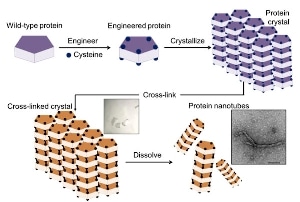Nov 15 2018
Tokyo Tech researchers have been successful in developing protein nanotubes from tiny scaffolds formed through the cross-linking of engineered protein crystals. The feat could speed up the creation of nano-sized carriers, artificial enzymes, and delivery systems for a wide array of biotechnological and biomedical applications.
 The method involved a four-step process: 1) introduction of cysteine residues into the wild-type protein; 2) crystallization of the engineered protein into a lattice structure; 3) formation of a cross-linked crystal; and 4) dissolution of the scaffold to release the protein nanotubes. (Image credit: Tokyo Institute of Technology)
The method involved a four-step process: 1) introduction of cysteine residues into the wild-type protein; 2) crystallization of the engineered protein into a lattice structure; 3) formation of a cross-linked crystal; and 4) dissolution of the scaffold to release the protein nanotubes. (Image credit: Tokyo Institute of Technology)
A research team, headed by Takafumi Ueno at Tokyo Institute of Technology’s Department of Biomolecular Engineering, has developed a novel way for assembling proteins into well-ordered nanotubes.
The latest breakthrough could speed up the development of delivery systems, nano-sized carriers, and artificial enzymes for various biotechnological and biomedical applications.
Customized protein nanostructures have been the subject of intense research because they can be possibly used for developing targeted vaccine and drug delivery systems, powerful and highly specific catalysts, and for designing a number of other potential biomaterials.
When it comes to building protein assemblies in aqueous solution, researchers have encountered many difficulties because of the disordered ways in which proteins freely interact under varying conditions, for example, temperature and pH.
These problems are overcome by the novel technique, which uses protein crystals. The crystals act as a potential scaffold for proteins to self-assemble into the required structures. The study has been published in the journal Chemical Science.
Four steps are involved in the new method:
- preparing an engineered protein
- forming the protein crystal scaffold
- forming a cross-linked crystal
- dissolving the scaffold to release the protein nanotubes
Composed of the organized arrangement of assembled structures, the crystal system cross-links to stabilize the assembly and thus makes it easy to regulate the precise chemical interactions of interest—a feat that cannot be realized by cross-linking of proteins in solution.
Initially, the team selected RubisCO—a naturally occurring protein—as a building block to develop the nanotube. RubisCO can retain its shape because of its high stability, and its crystal structure from earlier research had made it conducive for the current study.
With the help of transmission electron microscopy (TEM) imaging at Suzukakedai Biomaterials Analysis Division of Tokyo Institute of Technology, the researchers successfully demonstrated the formation of the protein nanotubes. The research also showed that the protein nanotubes can possibly keep their enzymatic ability.
Our cross-linking method can facilitate the formation of the crystal scaffold efficiently at the desired position (specific cysteine sites) within each tube of the crystal. At present, since more than 100,000 protein crystal structures have been deposited in Protein data bank, our method can be applied to other protein crystals for construction of supramolecular protein assemblies, such as cages, tubes, sheets.
Professor Takafumi, Department of Biomolecular Engineering, Tokyo Institute of Technology.
The nanotube described in this analysis can be applied to a wide range of applications. It offers the environment for accumulating exogenous molecules that can be utilized as delivery platforms in pharmaceutical-related areas. Since the protein building block has the natural enzymatic activity, the nanotube can potentially be used for catalysis.